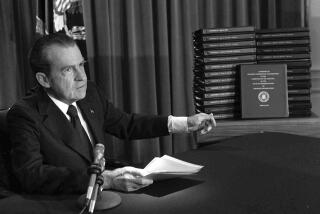WHO’S IN CONTROL? Polar Politics and the Sensible Center.<i> By Richard Darman (Simon & Schuster: $25, 367 pp.)</i>
- Share via
“President Reagan never even proposed a detailed budget that could bring spending down to the level he had promised in the 1980 campaign. And even that level was not exactly radical . . . within reasonable bounds, it was clear that debt, investment and some forms of tax reduction could pay for themselves. The Reagan tax cut’s supply-side enthusiasts took these defensible positions beyond their natural bounds. They transformed them into an extreme form of free lunch theory. . . . In the Reagan years, more federal debt was added than in the entire prior history of the United States. Interest costs alone rose to hundreds of billions of dollars per year. For federal policy-makers, the large deficit became an obsession and an albatross. Further, though the economy grew, prosperity remained elusive for millions of Americans. Urban civilization continued to decompose. For many in the middle class, the American dream seemed further away, not closer, at the decade’s end.”
****
Timing is everything. Dick Darman, the budget warhorse from the Reagan and Bush administrations, might not have guessed that his illuminating rehash of supply-side tax cuts and headache deficits would land him in the middle of the broil over Bob Dole’s sudden campaign conversion to tax cuts. At the table when the Reagan supply-siders got their way, Darman mocks the creed that somehow taxes can be reduced, defense spending increased, middle-class entitlements maintained and the deficit overcome by cutting “f.w.a.”--fraud, waste and abuse. The reader is left to wonder: If Reagan couldn’t make it happen, can Dole?
More to Read
Get the L.A. Times Politics newsletter
Deeply reported insights into legislation, politics and policy from Sacramento, Washington and beyond. In your inbox twice per week.
You may occasionally receive promotional content from the Los Angeles Times.










